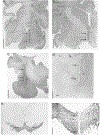Local administration of dopaminergic drugs into the ventral tegmental area modulates cataplexy in the narcoleptic canine
- PMID: 8891251
- PMCID: PMC9050244
- DOI: 10.1016/0006-8993(96)00541-0
Local administration of dopaminergic drugs into the ventral tegmental area modulates cataplexy in the narcoleptic canine
Abstract
Cataplexy in the narcoleptic canine may be modulated by systemic administration of monoaminergic compounds. In the present study, we have investigated the effects of monoaminergic drugs on cataplexy in narcoleptic canines when perfused locally via microdialysis probes in the amygdala, globus pallidus/putamen, basal forebrain, pontine reticular formation and ventral tegmental area of narcoleptic and control Doberman pinchers. Cataplexy was quantified using the Food-Elicited Cataplexy Test and analyzed by electroencephalogram, electroculogram and electromyogram. Local perfusion with the monoaminergic agonist quinpirole, 7-OH-DPAT and BHT-920, into the ventral tegmental area produced a dose-dependent increase in cataplexy without significantly reducing basal muscle tone. Perfusion with the antagonist raclopride in the same structure produced a moderate reduction in cataplexy. Local perfusion with quinpirole, 7-OH-DPAT and BHT-920 into the globus pallidus/putamen also produced an increase, while raclopride produced a decrease, in cataplexy in narcoleptic canines. In control animals, none of the above drugs produced cataplexy or muscle atonia when perfused into either the ventral tegmental area or the globus pallidus/putamen. Other monoaminergic drugs tested in these two brain areas; prazosin, yohimbine, amphetamine, SKF 38393 and SCH 23390 had no effects on cataplexy. Local perfusion with each of the above listed drugs had no effect on cataplexy in any of the other brain regions examined. These findings show that cataplexy may be regulated by D2/D3 dopaminergic receptors in the ventral tegmental area and perhaps the globus pallidus/ putamen. It is suggested that neurons in the mesolimbic dopamine system of narcoleptics are hypersensitive to dopaminergic autoreceptor agonists.
Figures







Similar articles
-
Cholinergic regulation of cataplexy in canine narcolepsy in the pontine reticular formation is mediated by M2 muscarinic receptors.Sleep. 1994 Aug;17(5):424-35. Sleep. 1994. PMID: 7991953 Free PMC article.
-
Cholinergic mechanisms in canine narcolepsy--I. Modulation of cataplexy via local drug administration into the pontine reticular formation.Neuroscience. 1994 Apr;59(3):511-22. doi: 10.1016/0306-4522(94)90173-2. Neuroscience. 1994. PMID: 8008205 Free PMC article.
-
Dopamine D3 agonists into the substantia nigra aggravate cataplexy but do not modify sleep.Neuroreport. 1999 Nov 26;10(17):3717-24. doi: 10.1097/00001756-199911260-00046. Neuroreport. 1999. PMID: 10619672
-
Dopamine D3 agonists into the substantia nigra aggravate cataplexy but do not modify sleep [corrected].Neuroreport. 1999 Sep 29;10(14):3111-8. doi: 10.1097/00001756-199909290-00043. Neuroreport. 1999. Corrected and republished in: Neuroreport. 1999 Nov 26;10(17):3717-24. doi: 10.1097/00001756-199911260-00046. PMID: 10549832 Corrected and republished.
-
Physiology of REM sleep, cataplexy, and sleep paralysis.Adv Neurol. 1995;67:245-71. Adv Neurol. 1995. PMID: 8848973 Review.
Cited by
-
Functional diversity of ventral midbrain dopamine and GABAergic neurons.Mol Neurobiol. 2004 Jun;29(3):243-59. doi: 10.1385/MN:29:3:243. Mol Neurobiol. 2004. PMID: 15181237 Review.
-
Animal models of narcolepsy.CNS Neurol Disord Drug Targets. 2009 Aug;8(4):296-308. doi: 10.2174/187152709788921717. CNS Neurol Disord Drug Targets. 2009. PMID: 19689311 Free PMC article.
-
'Sleep attacks' or 'unintended sleep episodes' occur with dopamine agonists: is this a class effect?Drug Saf. 2002;25(7):473-83. doi: 10.2165/00002018-200225070-00001. Drug Saf. 2002. PMID: 12093305 Review.
-
History of narcolepsy at Stanford University.Immunol Res. 2014 May;58(2-3):315-39. doi: 10.1007/s12026-014-8513-4. Immunol Res. 2014. PMID: 24825774 Free PMC article. Review.
-
Dopaminergic role in stimulant-induced wakefulness.J Neurosci. 2001 Mar 1;21(5):1787-94. doi: 10.1523/JNEUROSCI.21-05-01787.2001. J Neurosci. 2001. PMID: 11222668 Free PMC article.
References
-
- Aldrich MS, The neurobiology of narcolepsy-cataplexy, Prog. Neurobiol, 41 (1993) 533–541. - PubMed
-
- Aldrich MS, Hollingsworth Z. and Penney JB, Autoradiographic studies of postmortem narcoleptic brain, Neurophysiol. Clin, 23 (1993) 35–45. - PubMed
-
- Anden NE, Nilsson H, Ros E. and Thornstrom U, Effects of BHT-920 and BHT-933 on dopamine and noradrenaline receptors in the rat brain, Acta Pharmacol. Toxicol, 52 (1983) 51–56. - PubMed
-
- Baggeta G, De Sarro GB, Priolo E, Marra R. and Nistico G, Inhibition by pertusis toxin of the soporific effects induced by stimulation of dopamine D2 autoreceptors in the ventral tegmental area in rats, Neuropharmacology, 28 (1989) 941–947. - PubMed
Publication types
MeSH terms
Substances
Grants and funding
LinkOut - more resources
Full Text Sources
Miscellaneous

